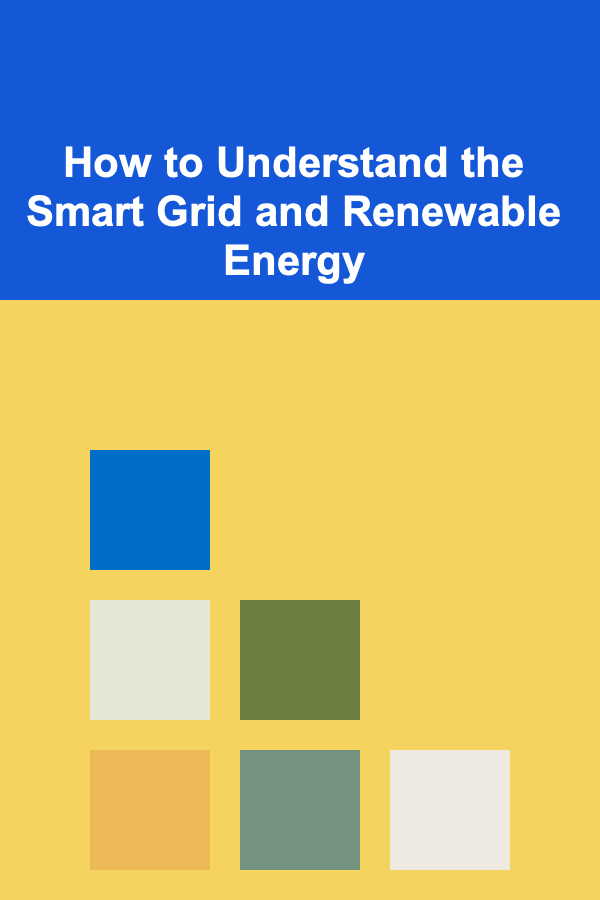
How to Understand the Smart Grid and Renewable Energy
ebook include PDF & Audio bundle (Micro Guide)
$12.99$9.99
Limited Time Offer! Order within the next:

The concept of the smart grid and its integration with renewable energy sources represents a critical evolution in the way we generate, distribute, and consume electricity. With the increasing demand for sustainable and reliable energy systems, understanding these two interconnected concepts is essential for anyone interested in the future of energy.
This article will explore the components and functions of the smart grid, the role of renewable energy within it, and how these technologies together are shaping a cleaner, more efficient energy landscape. By delving into the technologies, challenges, and benefits associated with the smart grid and renewable energy, this article aims to provide a comprehensive understanding of how they interact and why they are pivotal for the future.
What is the Smart Grid?
A smart grid is an advanced electrical grid system that uses digital communication, automation, and other intelligent technologies to monitor, control, and optimize the generation, distribution, and consumption of electricity. Unlike traditional grids, which operate on a one-way flow of electricity from power plants to consumers, a smart grid allows for two-way communication between utilities and consumers, enabling real-time monitoring, improved reliability, and energy efficiency.
The core features of a smart grid include:
1. Two-Way Communication
Smart grids utilize digital communication technology to provide real-time feedback from the electricity consumer to the utility company. This interaction enables utilities to monitor energy usage, detect faults, and respond more effectively to problems, thus improving grid reliability.
2. Automation
Automation plays a significant role in smart grids. Through the integration of smart sensors, remote-control devices, and automation systems, utilities can manage power flow, reduce outages, and optimize the distribution of energy without requiring manual intervention. This means quicker response times to disturbances and a more efficient distribution network.
3. Advanced Metering Infrastructure (AMI)
AMI is a system that measures energy consumption in real-time and transmits the data to utility companies for analysis. These advanced meters enable consumers to track their own energy use and make informed decisions to reduce consumption, while also allowing utilities to better understand usage patterns and manage energy resources more effectively.
4. Demand Response
Smart grids can facilitate demand response programs, where consumers adjust their energy usage based on signals from the grid. For instance, consumers may be incentivized to use less electricity during peak demand periods, thus helping utilities manage load and avoid grid congestion.
5. Energy Storage Integration
Smart grids can incorporate energy storage systems such as batteries to store surplus energy generated during low-demand periods. This energy can then be used during high-demand periods, thus reducing the need for additional fossil fuel-based power generation and improving grid resilience.
6. Renewable Energy Integration
A smart grid's ability to integrate renewable energy sources (such as wind, solar, and hydropower) is one of its defining characteristics. Since renewable energy generation can be intermittent and variable, smart grids use real-time data to ensure a consistent supply of electricity, balancing renewable sources with traditional generation methods.
The Role of Renewable Energy in the Smart Grid
Renewable energy sources have gained tremendous momentum in recent years due to their environmental benefits and decreasing costs. Integrating renewable energy into the existing grid infrastructure presents both opportunities and challenges. The smart grid plays a crucial role in ensuring that these renewable sources can be effectively harnessed and distributed to consumers.
1. Intermittency of Renewable Energy
The main challenge in integrating renewable energy, particularly solar and wind, into the grid is their intermittency. Solar power is only generated during daylight hours, while wind power depends on variable weather patterns. This creates fluctuations in electricity generation, which can make it difficult for traditional grids to maintain a steady power supply.
The smart grid addresses this challenge by enabling utilities to predict energy production from renewable sources in real-time, balance supply and demand, and store excess energy when it is abundant. For instance, energy storage systems can capture surplus energy generated during sunny or windy periods, making it available when production drops.
2. Grid Stability and Reliability
A reliable power grid must maintain a constant frequency and voltage. With the integration of renewable energy sources, especially distributed generation like rooftop solar, maintaining grid stability becomes more complex. The smart grid addresses this by using advanced control systems that automatically adjust the power flow, ensuring grid stability even when renewable energy sources fluctuate.
For example, in the case of solar power, if a cloud passes over a solar farm, the system may detect the drop in generation and immediately adjust the flow from other sources, such as natural gas or hydroelectric plants, to compensate. This type of real-time adjustment ensures that the grid remains stable and reliable despite the unpredictable nature of renewable energy generation.
3. Energy Management and Optimization
Smart grids enable advanced energy management strategies that optimize the use of renewable energy. These strategies include:
- Time-of-use pricing: Encouraging consumers to use electricity during times when renewable energy generation is high, such as midday for solar power.
- Grid balancing: Using real-time data to adjust power distribution, ensuring that excess energy from renewable sources can be stored or redirected to where it is needed most.
- Demand-side management: Allowing consumers to adjust their usage based on signals from the grid, reducing strain on the grid during peak hours and making better use of renewable resources.
4. Decentralization and Distributed Generation
One of the key features of the smart grid is its ability to accommodate distributed generation, where energy is generated closer to where it is consumed. This is particularly relevant for renewable energy, which can be generated at individual homes or businesses through solar panels, small wind turbines, or other local sources.
Distributed generation reduces transmission losses, as electricity does not have to travel as far from power plants to consumers. The smart grid's real-time monitoring and communication capabilities make it easier to integrate these decentralized renewable energy sources into the grid without sacrificing reliability or efficiency.
How the Smart Grid Benefits Renewable Energy Integration
The smart grid offers numerous advantages when it comes to supporting the integration of renewable energy sources. Some of these benefits include:
1. Improved Efficiency
Smart grids optimize the use of existing infrastructure by providing real-time data on energy demand and supply. This ensures that renewable energy is used most effectively, reducing wastage and improving overall energy efficiency. Furthermore, by integrating demand response programs, the smart grid can shift demand to times when renewable energy generation is abundant, maximizing its utilization.
2. Enhanced Reliability
By integrating energy storage systems and utilizing real-time data, the smart grid improves the reliability of the power supply. When renewable energy generation is low, the grid can draw from stored energy or other sources, ensuring a continuous and stable supply of electricity. This helps address the challenges of variability and intermittency often associated with renewable energy.
3. Cost Savings
While the initial investment in smart grid infrastructure can be high, the long-term savings are substantial. Smart grids reduce the need for costly infrastructure upgrades, as they allow utilities to make better use of existing resources. Additionally, by optimizing energy use and integrating renewable energy more effectively, smart grids can help reduce electricity costs for consumers.
4. Environmental Benefits
The integration of renewable energy into the smart grid reduces reliance on fossil fuel-based power generation. This helps lower greenhouse gas emissions and promotes cleaner, more sustainable energy practices. By improving grid efficiency and facilitating the use of renewable sources, the smart grid supports global efforts to combat climate change.
Challenges in Implementing the Smart Grid and Renewable Energy
While the potential benefits of the smart grid and renewable energy integration are clear, several challenges remain in their implementation:
1. High Initial Costs
Building and deploying a smart grid requires significant investment in infrastructure, including smart meters, communication networks, energy storage systems, and automation technologies. While these costs are expected to decrease over time, they remain a barrier to widespread adoption, especially in developing regions.
2. Cybersecurity Risks
The reliance on digital communication and automation in smart grids makes them vulnerable to cyberattacks. A breach in the grid's control systems could disrupt energy distribution, compromising the reliability of the entire system. Securing smart grids against cyber threats is a critical challenge that requires continuous monitoring and investment in advanced security technologies.
3. Regulatory and Policy Issues
The successful implementation of the smart grid and renewable energy integration requires clear regulatory frameworks that encourage investment and innovation while ensuring consumer protection. Policymakers must navigate complex issues related to pricing, grid access, and incentives for renewable energy development. Effective coordination between government, utilities, and industry stakeholders is essential to address these challenges.
4. Public Acceptance and Education
The adoption of smart grid technologies often requires changes in consumer behavior and increased public understanding of how these technologies work. Educating consumers about the benefits of smart meters, demand response programs, and energy efficiency is crucial for achieving widespread acceptance and participation in these programs.
Conclusion
The combination of the smart grid and renewable energy is transforming the global energy landscape. By enabling more efficient, reliable, and sustainable electricity generation and distribution, the smart grid plays a pivotal role in supporting the integration of renewable energy sources. However, challenges such as high upfront costs, cybersecurity risks, and regulatory issues must be addressed to ensure the successful adoption of these technologies.
As we move toward a more sustainable energy future, the continued development and integration of the smart grid and renewable energy will be crucial in reducing our dependence on fossil fuels, minimizing environmental impacts, and creating a cleaner, more efficient energy system. Through innovation, investment, and collaboration, we can unlock the full potential of these technologies and build a resilient and sustainable energy future for all.
Reading More From Our Other Websites
- [Home Storage Solution 101] How to Keep Your Home Office Clutter-Free with Proper Storage
- [Digital Decluttering Tip 101] Best Cloud Storage Organization Techniques for Remote Teams
- [Home Family Activity 101] How to Plan a Family Picnic Indoors During Winter
- [Personal Care Tips 101] How to Choose a Hair Mask for Fine Hair
- [Organization Tip 101] How to Rotate Your Collection Seasonally for Fresh Inspiration
- [Personal Investment 101] How to Start Investing in Cryptocurrency Safely
- [Organization Tip 101] How to Create a Cozy and Warm Bathroom with a Rustic Vanity
- [Organization Tip 101] How to Maintain a Minimalist Lifestyle After Decluttering
- [Home Party Planning 101] How to Decorate Your Home for a Festive Atmosphere
- [Skydiving Tip 101] From Panic to Thrill: Real-World Tips for Conquering Skydiving Anxiety

Building an Engaging Content Portfolio as a Content Editor
Read More
How to Save Money on Transportation Costs Without Compromising Convenience
Read More
How To Create a Bold Lip and Minimal Eye Look
Read More
Mastering Time Management for Entrepreneurs: A Comprehensive Guide
Read More
How to Track Player Progress and Identify Areas for Improvement
Read More
How to Navigate Insurance and Pre-Authorization for Doctor Appointments
Read MoreOther Products

Building an Engaging Content Portfolio as a Content Editor
Read More
How to Save Money on Transportation Costs Without Compromising Convenience
Read More
How To Create a Bold Lip and Minimal Eye Look
Read More
Mastering Time Management for Entrepreneurs: A Comprehensive Guide
Read More
How to Track Player Progress and Identify Areas for Improvement
Read More